Recent Articles
Popular Makes
Body Types
2021 Jeep Gladiator EcoDiesel Road Test and Review
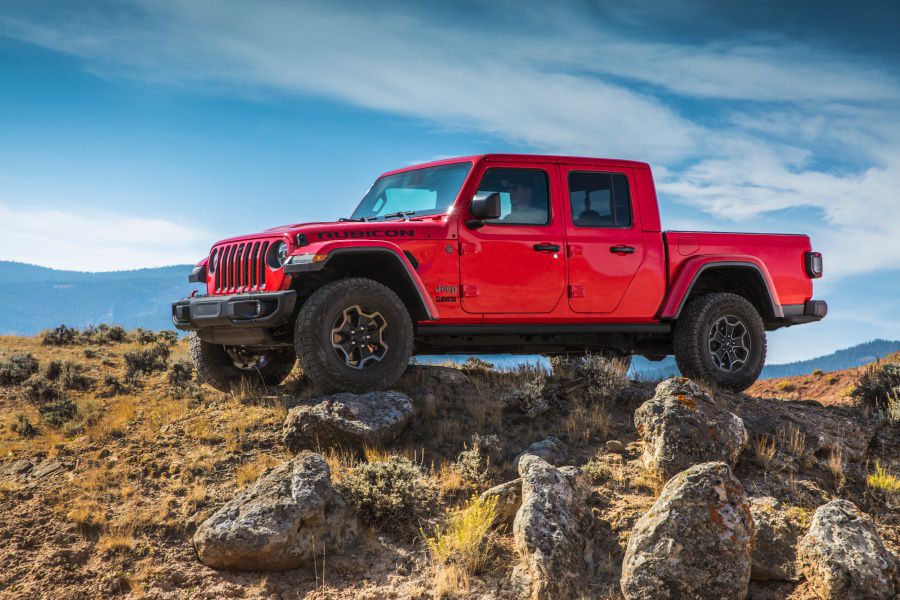
2021 Jeep Gladiator Rubicon ・ Photo by Fiat Chrysler Automobiles
When Jeep introduced its first pickup truck in nearly two decades, the Wrangler-based Gladiator, fans of the brand were elated. And then, almost immediately, they wanted to know when a diesel engine would be available for it. As it turns out, the wait was a short one. Enter the 2021 Jeep Gladiator EcoDiesel, equipped with the same 3.0-liter turbodiesel V6 engine the company offers in the Wrangler SUV. Supplying stump-pulling torque, the new 2021 Gladiator EcoDiesel is more fuel-efficient, more pleasurable to take off-road, and, depending on the trim level, capable of towing a bigger trailer and hauling more payload.
The diesel is just one of several changes to the 2021 Jeep Gladiator lineup. A full-time four-wheel-drive system is now available on all versions of the truck, Sport trim can be fitted with LED headlights and fog lights, and Overland trim now includes a TrailCam forward-facing camera accessible through the infotainment system. Additionally, new Willys, 80th Anniversary Edition, and High Altitude versions of the 2021 Gladiator debut, while the Altitude and North Edition versions depart.
2021 Jeep Gladiator Prices and Lineup
As the 2021 model year kicks off, there are eight versions of the Gladiator available. The Sport is the least expensive at $33,545, but it’s also very basic in terms of equipment. At the other end of the lineup is the new luxury-themed High Altitude, priced at $51,745. In between, you’ve got Willys Sport, Sport S, Willys, Overland, Rubicon, and Mojave variants — that last one a special version equipped with suspension and cooling systems designed for desert-running at speed.
Our test vehicles included an Overland with the EcoDiesel option ($47,890) and a Rubicon with the EcoDiesel option ($51,370). If you haven’t worked the math already, the EcoDiesel engine costs $4,000 and it requires a $2,000 automatic transmission (which you were probably getting anyway). Is the diesel upgrade worth the price? That depends on why you want it.
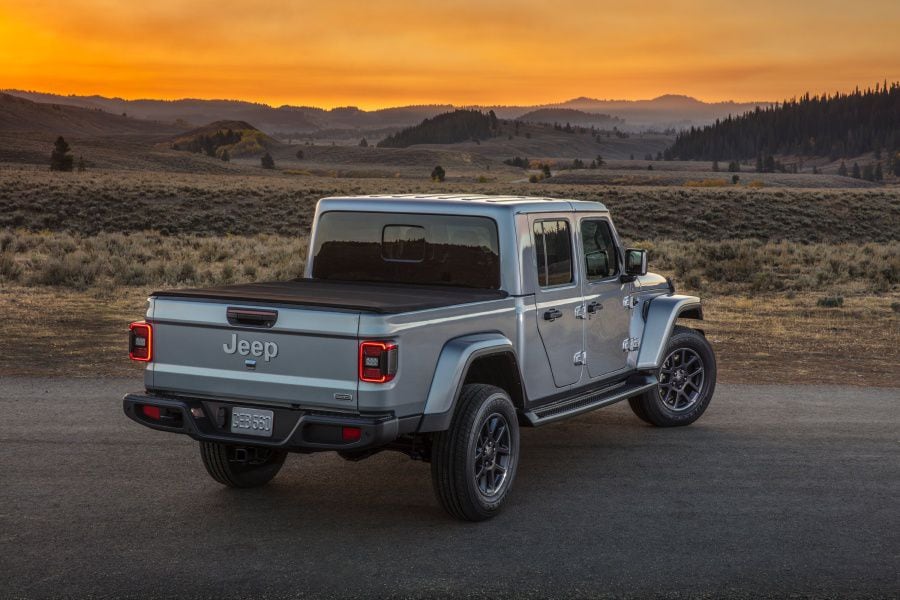
Photo by Fiat Chrysler Automobiles
New Versions of the Gladiator for 2021
For 2021, the Gladiator looks just like it did last year except for a new Snazzberry paint color. That is, unless you choose a Willys, an 80th Anniversary Edition, or a High Altitude. The Willys trim is based on the Sport and Sport S. Both include rock rails, a Trac-Lok limited-slip differential, and 32-inch mud-terrain tires mounted to specific 17-inch black aluminum wheels. They also have body-color fenders, a black grille and headlight surrounds, and unique Willys-themed graphics.
The 80th Anniversary Edition is based on the Gladiator Overland. It has all-terrain tires, dark gray instead of chrome accents, keyless entry, remote engine start, the top infotainment system with a premium sound system, and special badges. The High Altitude has body-color fenders, bumpers, and side steps, dark headlight rings and grille slot accents, and gloss black 20-inch wheels wrapped in 275/55 all-season tires. A body-color three-piece hardtop is standard, and the interior gets quilted premium Nappa leather.
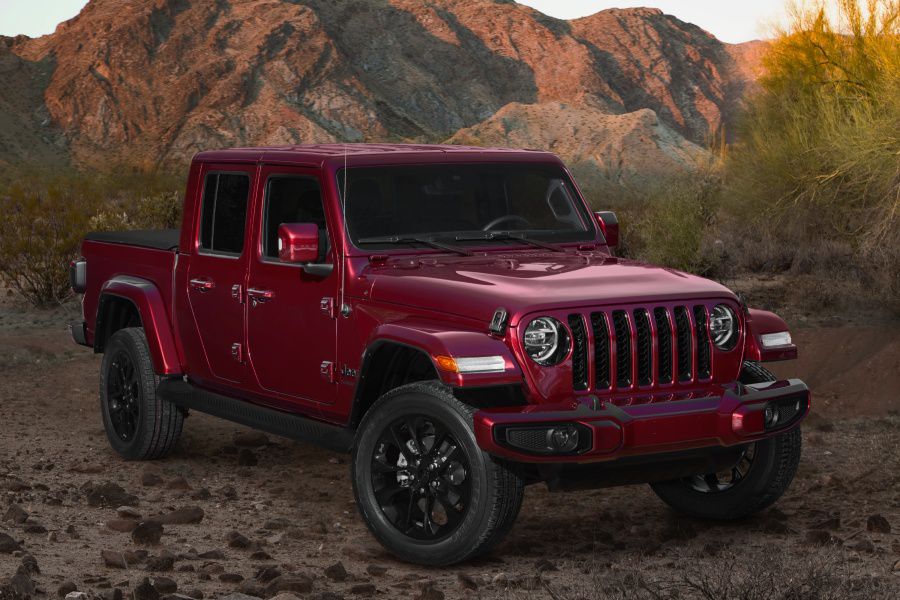
Photo by Fiat Chrysler Automobiles
Gladiator Off-Roading Technology
Though rudimentary in its most basic form, the 2021 Gladiator offers quite sophisticated technologies developed specifically for off-roading. One of the most useful is Selec-Speed, an off-roading cruise control system that is standard with the Gladiator’s optional automatic transmission. Activate the system, use the manual shift gate to adjust speed, and this technology will automatically maintain a specific low travel speed when off-roading, allowing the driver to focus on finding the best path forward and steering.
Through the Off-Road Pages menu within the infotainment system, a TrailCam provides the driver with a clear, unobstructed view of what’s in front of the Gladiator. This is especially helpful when cresting hills and the trail ahead is blocked from view by the truck’s hood. The Rubicon offers electronic locking front and rear differentials, an electronic disconnecting sway bar, and a Rock-Trac 4:1 transfer case. During an off-roading adventure in Southern California’s Santa Monica Mountains, we used all of these features, as well as the TrailCam and Selec-Speed. And with the new EcoDiesel engine, the Rubicon proved unstoppable.
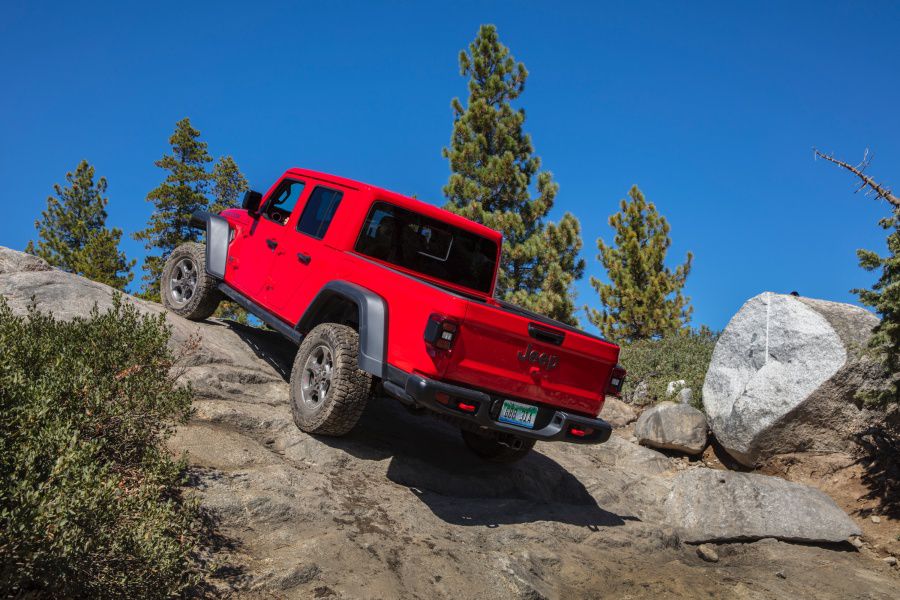
Photo by Fiat Chrysler Automobiles
EcoDiesel Specs, Fuel Economy, and Availability
The 2021 Jeep Gladiator’s new EcoDiesel engine is a 3.0-liter turbodiesel V6. It’s essentially the same one that’s available for the Wrangler, but it is calibrated a bit differently because Gladiator owners are more likely to tow a trailer. Plus, the Gladiator has a different exhaust system.
As is true in the Wrangler, the Gladiator’s EcoDiesel is generating 260 horsepower at 3,600 rpm and 442 lb-ft of torque from 1,400 rpm to 2,800 rpm. Compare that to the standard 3.6-liter V6, which churns out 285 hp at 6,400 rpm and 260 lb-ft of torque at 4,400 rpm. It comes only with an eight-speed automatic transmission, one fortified to handle the engine’s torque. Clearly, the EcoDiesel delivers lots of power down low in the Gladiator’s rev range, and it makes significantly more torque than the gasoline-fueled V6. Plus, according to the EPA, the Gladiator’s standard V6 returns 19 mpg in combined driving while the EcoDiesel bumps that number to 24 mpg. Jeep offers the EcoDiesel option for all Gladiators except the Desert-Rated Mojave model. We sampled the engine in the Overland and the Rubicon.
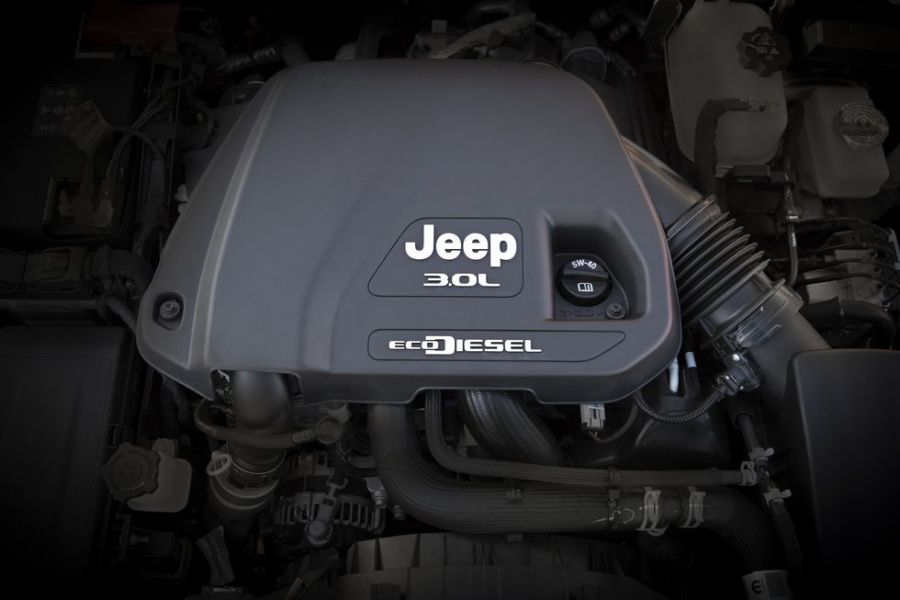
Photo by Fiat Chrysler Automobiles
Driving the Gladiator EcoDiesel on Pavement
Starting off in the Gladiator Overland, we headed out of the Santa Monica Mountains to drive on the city streets and wide freeways of the Thousand Oaks, California, region. In this setting, on a warm day with the climate control system blasting, the truck’s automatic engine stop/start system did not activate, but it easily returned fuel economy over 20 mpg. You need not rev the engine much in this environment, as the torque effortlessly motivates the Gladiator as you drive from light to light while threading through afternoon traffic.
Accelerating up a steep freeway on-ramp, the EcoDiesel steadily and quickly brought the Jeep up to speed, leading a pack of cars as we joined fast-flowing traffic. It doesn’t take much in the way of velocity for the excessive wind and road noise to muffle the subtle EcoDiesel clatter coming from beneath the hood. Later, heading back into the mountains, the Overland chugged up grades with a seeming shrug, and upon arrival back at Jeep’s staging location, we’d averaged 22.6 mpg.

Photo by Fiat Chrysler Automobiles
Driving the Gladiator EcoDiesel Off-Road
After switching into a Rubicon EcoDiesel, a professional off-roading instructor took us deeper into the mountains on a private trail. Dense brush, tight turns, deep ruts, steep grades, and large rocks lay in wait, but the Gladiator Rubicon took it all in stride even if the lengthy truck needed to make a couple of three-point turns.
The EcoDiesel option shines brightest off-road, where its prodigious low-rev torque makes it easier to fine-tune throttle application as you crawl along on a trail. Compared to the standard V6, a driver doesn’t need to get revs up to access thrust, so crossing difficult terrain is a more controlled experience. This is especially true when using Selec-Speed. With the off-road cruise control set, the Gladiator Rubicon EcoDiesel relentlessly marches over whatever is in its path, and seemingly at idle. It is a confidence-inspiring experience. According to Jeep, about 15 percent of 2021 Gladiator buyers will choose the EcoDiesel engine, and most of them will be installed in the Rubicon.
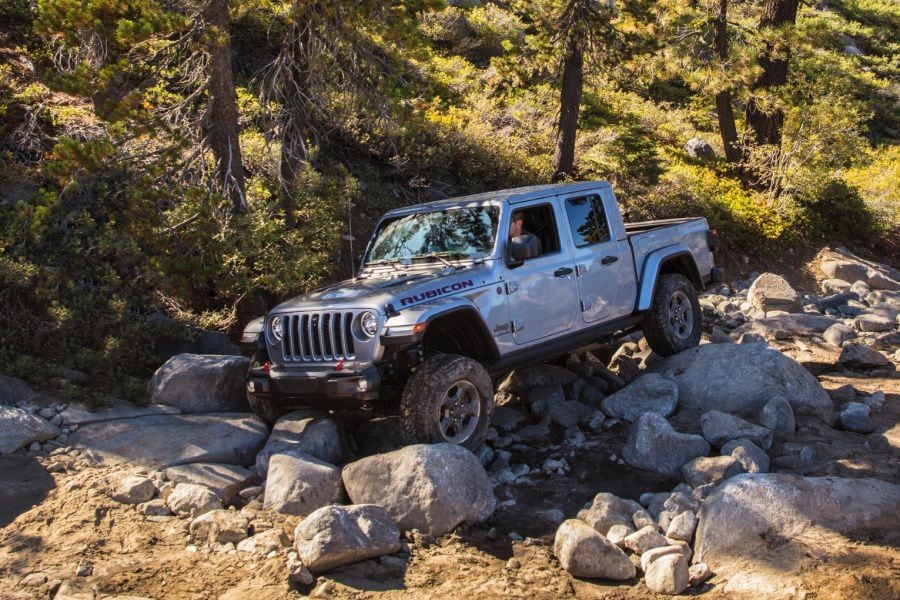
Photo by Fiat Chrysler Automobiles
Towing and Payload Ratings
With the standard gas V6 engine, an automatic transmission, and a 4.10 rear axle ratio, a Gladiator Sport will tow up to 7,650 pounds. Otherwise, the gas engine can handle between 4,000 and 7,000 lbs of trailer, depending on transmission and trim level.
The Gladiator EcoDiesel is rated to tow 6,500 lbs except in the Rubicon, where the rating is 6,000 lbs, or half a ton less than the Rubicon gas. As far as payload ratings are concerned, figures range from 1,075 lbs for the Rubicon to 1,325 for the Sport. Generally speaking, these figures are lower than for the gas V6. Jeep says the drivetrain could tow more weight, but with the Gladiator’s seven-slot grille design and the addition of an intercooler under the hood, cooling concerns prompted the company to limit tow ratings. However, even in models where the EcoDiesel is rated to tow less weight, Jeep says the experience is superior to the gas V6 because of, you guessed it, torque.
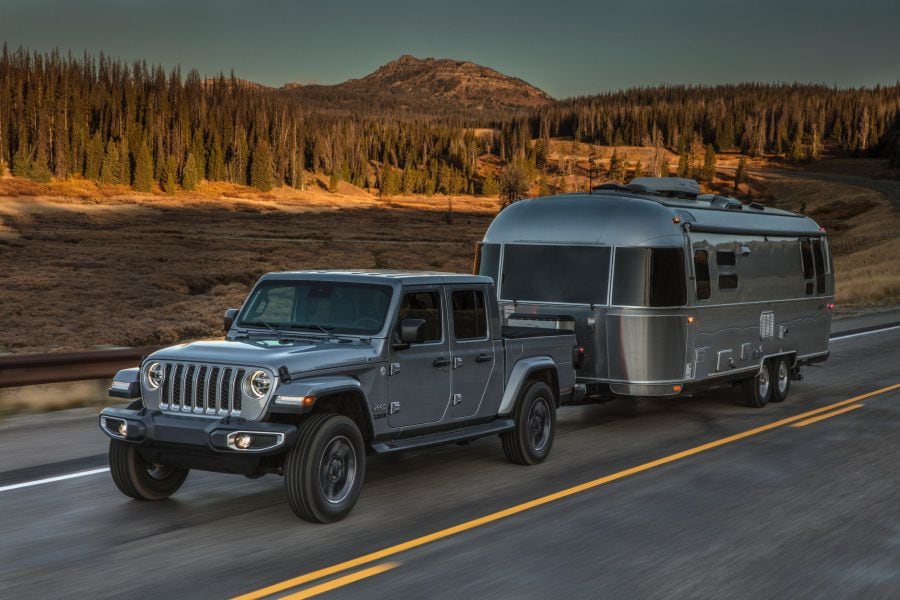
Photo by Fiat Chrysler Automobiles
Open-Air Towing and Hauling Puts the Gladiator in a Class of One
The 2021 Jeep Gladiator competes with other mid-size pickup trucks including the Chevrolet Colorado, Ford Ranger, GMC Canyon, Honda Ridgeline, Nissan Frontier, and Toyota Tacoma. All but the Ridgeline offer a dedicated off-roading version, some (Colorado ZR2, Tacoma TRD Pro) more capable than others (Frontier Pro-4X).
The only other diesel engine in the segment is a turbocharged 2.8-liter 4-cylinder offered in the Colorado and Canyon, which tops out at 181 hp and 369 lb-ft of torque. However, the Chevy and GMC can tow up to 7,700 lbs (5,000 lbs in the Colorado ZR2 trim) and haul as much as 1,495 lbs of payload. While the midsize trucks from General Motors can tow and haul more with their diesel engines, you can’t take the roof, windows, and doors off of a Colorado or a Canyon, now can you?
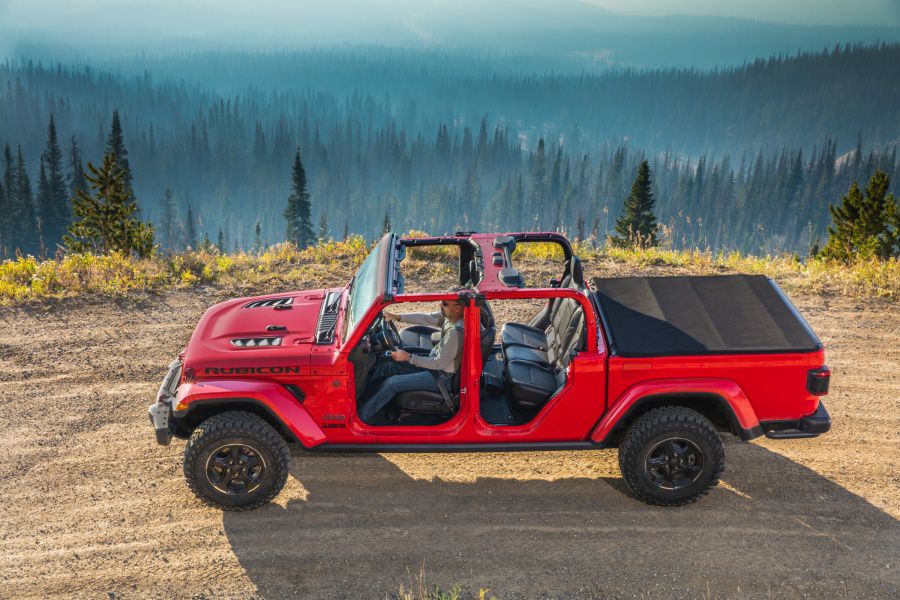
Photo by Fiat Chrysler Automobiles
Should I get a Jeep Gladiator EcoDiesel?
The Jeep Gladiator is unlike any other mid-size pickup truck, and while its Wrangler roots are a turn-off for some people, for others they’re the main reason to choose this truck over the competition.
But, should you pay the extra $4,000 for the EcoDiesel? It will take forever to get that cash back in the form of savings at the fuel station, so if you’re thinking the “Eco” part of the equation makes the EcoDiesel worthy, we’d say no. However, if you plan to tow with a Gladiator, or spend significant time traveling over tough terrain, then the answer is a clear yes. The improved fuel economy, plus the effortless towing character, plus the relentlessness of this powertrain while off-roading, all adds up to a recommendation from us.
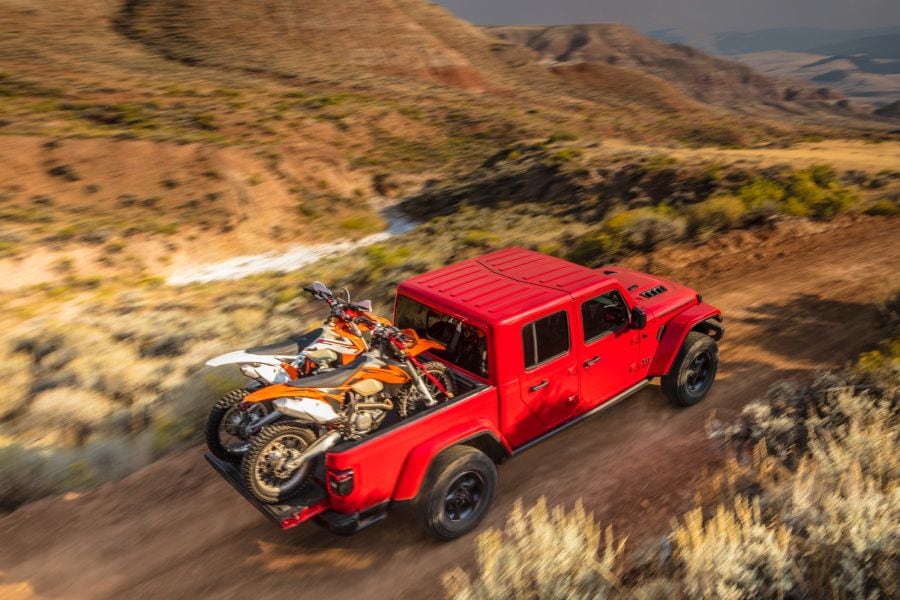
Photo by Fiat Chrysler Automobiles